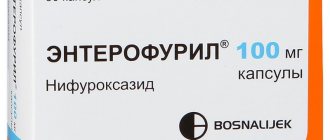Treatment of vomiting and diarrhea in children of different ages
If a child is sick, parents will be required to provide first aid before the doctor arrives. Simple measures will help improve the baby’s condition and prevent the development of possible complications. Your actions in this situation will depend on the age of the child.
Diarrhea and vomiting in infants
If the baby is not yet 1 year old and is breastfed, give breastfeeding on demand. Even if you apply more often than usual, don't worry. Your baby now needs to replenish lost fluids and nutrients. Also, in addition to breast milk, spoon or bottle another liquid after each bout of vomiting or diarrhea.
By independently deciding what needs to be done before the pediatrician arrives, parents assume full responsibility for their child’s condition. Very often, “in the old fashioned way,” a tablet of levomycetin is given for diarrhea and, if you’re lucky, the child’s diarrhea stops.
But not everyone knows that this drug is an antibiotic, and the binding effect is just a side effect of this drug. Moreover, the binding effect can be so strong that the child will not go to the toilet for the next few days.
In addition, do not forget that taking antibiotics is only effective in the case of a bacterial infection, which is extremely unlikely in the case of diarrhea. And even in such a situation, you can get by using safer methods.
Antidiarrheal drugs
Depending on the diagnosis received, the child is prescribed treatment, prescribed medications and, if necessary, hospitalized. Children under one year old with poisoning or intestinal infections are required to undergo hospital treatment.
How to stop vomiting in a baby? List of drugs for drug treatment:
- antiemetics (Motilium, Hexal, Domperidone, etc.);
- antidiarrheals (Lactobacterin, Bifidobacterin);
- enterosorbents;
- antibiotics to eliminate viruses and infections (Enterofuril, Enterol));
- probiotics to restore the body's microflora;
- antihistamines (if symptoms are caused by an allergic reaction);
- antispasmodics to prevent colic and spasms.
All medications for nausea and vomiting should be taken only as prescribed by a doctor. You can stop the disease yourself only with sorbents, antispasmodics and rehydration drugs.
What kind of vomiting happens?
Vomiting is a protective mechanism.
Vomiting is the uncontrolled expulsion of stomach contents through the oral or nasal cavity with a characteristic sound. At first, parents may think that the baby is choking. Physiologically, this is a contraction of the diaphragm and abdominal muscles.
As a rule, nausea precedes vomiting. It does not cause pain and manifests itself subjectively through anxiety, refusal to eat, pallor, and chills. Vomiting is the body's defense mechanism against the effects of ingested toxins. This is a symptom of intoxication, diseases of the endocrine system and gastrointestinal tract.
Therefore, it is so important to determine the cause of its occurrence. To do this, you need to study the vomit, which differs in color and consistency.
Vomiting with mucus
For an infant, vomiting with mucus is normal. This is a common sign of overeating. Mucus enters the mass from the nose and bronchi. If the child is older, then the situation should be alarming.
The causes of mucous “regurgitation” can be serious:
- food poisoning;
- diseases of the nervous system;
- exacerbation of chronic gastritis if the diet has been disrupted;
- viral infections;
- inflammation of the mucous membranes of the stomach (due to taking certain antipyretic and analgesic medications).
Vomiting bile
Vomiting bile may indicate food poisoning, overeating or eating fatty and spicy foods.
The color of vomit mixed with bile is yellowish-green. This will leave a bitter taste in the child's mouth. This is a symptom:
- food poisoning;
- overeating;
- excessive consumption of fatty, overcooked and spicy foods.
Bloody vomiting
As soon as you see traces of blood in your child’s vomit, call a doctor immediately. This is a sign of bleeding in the upper esophagus. If the blood is scarlet, then the pharynx, oral cavity, esophagus or the upper part of the stomach itself is affected. Coffee color indicates lesions in the intestinal area. The reasons may be as follows:
- severe poisoning (mushrooms, poisons);
- ulcer;
- foreign objects entering the esophagus;
- erosive processes in the stomach or intestines.
If untidiness happened to a breastfeeding baby, it is possible that maternal blood entered through the milk through cracks in the nipples.
How to treat vomiting in a child
If any symptoms of the disease appear, you should not give your child the first available medicine for diarrhea and vomiting. The situation may be much more serious than you think, and with your own initiative you will simply distort the clinical picture. Pay attention to all the above features, and only then make a decision.
There are a number of cases when a child urgently needs qualified help. Therefore, call an ambulance or take your baby to the hospital yourself in the following situations:
- The age of the young patient is 3 years and younger (primarily this applies to infants and newborns).
- If vomiting and diarrhea are accompanied by a fever above 38 0C.
- The presence of blood in the stool.
- Repeated attacks of vomiting (4 times or more).
- Continuous diarrhea throughout the day with bowel movements more than 6 times.
- Refusal to eat and drink. Vomiting after every meal or liquid.
- When the first signs of dehydration appear (dry lips, sunken eyes and fontanel, crying without tearing, drowsiness).
In all other cases, if the child’s condition does not worsen, call the pediatrician at home. After the examination, he will give instructions on how to treat the baby.
No matter what medications and folk remedies you treat your child with, without actively replenishing fluid reserves in the body, even the most effective pills for nausea and diarrhea will not give the expected effect. Firstly, water is necessary for the absorption of active substances into the blood, and its deficiency is very acute during vomiting and diarrhea.
Well, secondly, during such a period, the body experiences a disturbance in the water-salt balance and a decrease in glucose levels, which aggravates the patient’s condition.
To replenish fluid reserves, it is not recommended to use pure water, juices, tea, milk or broth. According to experts, these drinks will only once again provoke the gag reflex. And the salt content in them is too low, which will only intensify the dehydration effect. So, if possible, during the treatment process you should give pharmaceutical drugs in powder form for the preparation of solutions and emulsions.
Alternatively, if medication is not available, you can make a saline solution at home. To do this, take 4 tsp per liter of clean water. sugar and 1 tsp. salt, mix it all and give it to the child as needed (after each case of vomiting or bowel movement). The shelf life of the prepared solution is 24 hours.
Treatment to prevent dehydration should begin an hour after the child begins vomiting or the first symptoms of intestinal distress appear.
If the causes of vomiting are independently established and do not cause concern for parents, this is good. But there are situations when calling a doctor or an ambulance is mandatory. Qualified medical care, capable of prescribing timely and correct treatment, will be needed if:
- vomit is brown or red (blood),
- vomiting repeats very often, more than 2 times per hour,
- vomiting is accompanied by high fever and fainting,
- vomiting occurred after a head injury or fall,
- vomiting, which is accompanied by severe pain and diarrhea or, conversely, lack of stool.
First aid
It should be borne in mind that any condition of the baby accompanied by vomiting should be assessed by a doctor. Accordingly, only a specialist can make the correct diagnosis, carry out the necessary diagnostics and prescribe treatment on time!
When a child vomits, the parents’ task is to provide the child with proper care and try to save him from further vomiting attacks.
Nausea and vomiting a lot, but no fever - what could it be?
- If vomiting is accompanied by fever, diarrhea, abdominal pain, severe lethargy of the child to the point of loss of consciousness, pale skin, cold sweat, as well as when the baby is under 1 year old or with repeated vomiting in older children, you should immediately call a doctor for house!
- The child should be placed in bed with the head turned to the side, with a towel placed in case of repeated vomiting. It is better to hold an infant in your arms in a position on its side.
- Before the doctor arrives, you should stop feeding the child, even an infant.
- During attacks of vomiting, it is better to sit the child on a chair or on your lap, tilting his body slightly forward - to prevent vomit from entering the respiratory tract.
- After an attack, the child should rinse his mouth with water, wash, and change into clean underwear.
- You should not panic in front of a child - scream, wail, cry, because this will scare the baby even more. You should act calmly and decisively, supporting the little patient with words and strokes.
- After rinsing the mouth, the child can be asked to take a few sips of water. The water should not be very cold or hot - better than room temperature. Under no circumstances should you let your child drink juices, sparkling water or sparkling mineral water, or milk.
- To drink, the child should dilute a glucose-saline solution - for example, rehydron, gastrolit, tsitroglucosalan, oralit, etc. These drugs are sold in pharmacies without a prescription and should always be kept in your home medicine cabinet. The solution must be diluted strictly according to the recipe. The child should drink 1-3 teaspoons of the solution every 10 minutes. These solutions can also be given to infants, a few drops at a time and as often as possible. If the baby falls asleep, the solution can be administered with a pipette drop by drop behind the cheek, placing the head on one side, or in a horn with a pacifier.
- If vomiting is accompanied by diarrhea, after each bowel movement you should wash the baby and change his underwear.
- The child may be hospitalized, so you should pack the necessary things for the hospital, hygiene products, spare clothes, prepare a bag and have it at hand, and get dressed.
Reasons for concern and reasons to call a doctor (ambulance):
- Temperature increase.
- Unbearable abdominal pain, profuse diarrhea.
- Lethargy, loss of consciousness, cold sweat, pale skin.
- Child's age is up to 1 year.
- Repeated, incessant vomiting.
Parents should know what first aid is for a child vomiting before he is examined by a doctor. In 90% of cases, it helps to avoid unpleasant consequences, and also significantly alleviates the patient’s condition.
- Lay him in bed with his head turned to one side. Place a towel under your cheek and chin to vomit again.
- Place the baby in your arms horizontally on its side.
- Don't give anything to eat.
- Antipyretics (paracetamol) should be given only after the temperature rises to 38°C.
- During an attack, sit up, tilting your torso slightly forward. This will prevent vomit from entering the lungs.
- After each attack, rinse your mouth with clean, cool water, wash, and change clothes.
- Do not scare the child with panic: do not scream, do not wail, do not discuss his illness with others, do not cry. Act decisively, calmly, quickly. Support the patient with strokes and words.
- Parents often ask what to give their child when vomiting before the doctor arrives. After an attack, allow him to take 2-3 sips of water.
- It can be replaced with glucose-saline solutions, which are purchased at the pharmacy. In such cases, Regidron, Tsitroglucosalan, Gastrolit, Oralit, etc. are helpful. Dilute strictly according to the recipe. Drink 1-2 teaspoons every 10 minutes. Infants - 2-3 drops.
- As for a specific remedy, parents who do not know how to stop their child’s vomiting can recommend Smecta.
- After diarrhea, wash the child and change panties.
- Pack your things for hospitalization (just in case).
- Leave the vomit and feces for examination by a doctor.
But what to do if a child has vomiting without diarrhea and fever without any impurities or other dangerous symptoms? Be alert: do the same according to the instructions and carefully monitor his condition. At the first signs of deterioration or constantly recurring attacks, you still cannot do without qualified medical assistance.
And keep in mind: it is undesirable to transport a small patient yourself, as he will be shaken even more in the car and he may get worse. A series of diagnostic tests will await you at the hospital.
First of all, you need to avoid panic and try to establish the cause of the illness. Even if you had to call a doctor, you shouldn’t waste time, you need to know how to stop vomiting and take the following actions:
- The first thing you need to give your child when vomiting is a sufficient amount of fluid. If the child is small, you can give him to drink from a pipette or a teaspoon. This will prevent dehydration of the body. You can give it to water with solutions; one of the effective preparations for preparing a solution is rehydron.
- If there is blood in the vomit, give the child a small piece of ice to swallow and place an ice pack on the stomach. This will help stop internal bleeding. In this case, it is strictly forbidden to give the baby water.
- After vomiting, the child should be helped to rinse his mouth and wash his face to avoid irritation from stomach acid.
- Use medications carefully so as not to aggravate the situation. It is better to do this after examination by a doctor.
- Temporarily do not allow the child to eat.
- Provide the patient with bed rest and comfortable conditions. At the same time, lay the baby on his side so that vomit does not enter the respiratory tract.
A reminder for a nurse in a hospital to help a patient who is conscious of a vomiting attack:
- Warning the patient about assistance.
- Put an oilcloth apron on the patient.
- Place in a comfortable position.
- Prepare a glass of water to rinse your mouth.
- Place a container in front of the patient.
- Wear sterile gloves and an apron.
- Place your hand on your head and hold it while vomiting.
- After finishing the process, rinse your mouth with water.
- Remove the protective apron.
- Help me lie down.
- Show the doctor the vomit and disinfect it.
- Clean and ventilate the room.
- Take off your overalls.
- Wash the hands.
When a patient has uncontrollable vomiting, constant nursing supervision and care is required to prevent aspiration from occurring. If the body position is incorrect, the unconscious patient will choke.
Patients often experience a gag reflex after surgery. In the event of an attack of vomiting, when the patient is unconscious, the patient’s life depends on the action of the nurse. Without PMP, aspiration of vomit increases significantly. Nurse's action algorithm:
- Turn the patient's head and body to one side so that vomit does not enter the respiratory tract.
- Remove the pillow.
- Get your dentures.
- Tie a towel and bring the vomit basin to your mouth.
- Hold the patient's head while vomiting.
- Wrap your finger in gauze and clean your mouth.
- Open your mouth using your thumb and index finger.
- Clean your mouth until the mass is removed.
- Rinse your mouth with a bulb-shaped syringe.
- It is necessary for the doctor to familiarize himself with the contents.
- Disinfect with chlorine.
- Pour it down the drain.
- Wash and ventilate the room.
- Remove the apron.
- Disinfect your hands with the solution.
An unconscious patient should be under the constant supervision of a nurse. The body position is horizontal with the head turned to the side. Indication for unconscious patients is mandatory.
In case of nausea and one-time attacks, calling a doctor is not necessary, but there are a number of symptoms in which medical manipulation will save the life of a person who is under threat. These signs include:
- severe unbearable pain in the abdomen;
- contents mixed with blood;
- sharp deterioration in condition;
- the attack began after a head injury;
- the attack is strong and does not stop;
- vomiting in an elderly person.
Medicines for vomiting and diarrhea
The list of medications for the treatment of diarrhea and vomiting is as extensive as the list of causes that provoked the malaise. Depending on the type of disease, the following drugs are used in pediatric practice:
- antiemetics – cerucal, motilium (in the hospital);
- antidiarrheals - loperamide, lopedium, loflatil, imodium;
- sorbents – activated carbon, polysorb, enterosgel, atoxyl, smecta;
- probiotics – lactofiltrum, hilak-forte, lactiale, linex;
- hormones and antihistamines for allergic reactions;
- antacids for gastric pathologies;
- antibiotics for intestinal infections (selectively);
- antispasmodics – papaverine, no-spa;
- rehydrants for replenishing fluid reserves - rehydron, glucosolan.
Treatment of children under one year of age, regardless of the cause of nausea and diarrhea, is carried out in a hospital setting.
Prevention
In order to stop vomiting in a child at home, it is necessary to maintain hygiene, carefully monitor the quality and freshness of food, as well as the correct preparation of food. The main recommendations include the following:
- All food must be fresh.
- Meat, eggs, fish, dairy products must have seller certificates and undergo heat treatment.
- Before giving vegetables and fruits, they must be thoroughly washed and wiped.
- Water should only be consumed bottled, purified or boiled.
- Immunity must be maintained at a high level.
- The child should be in a favorable atmosphere.
- In case of vomiting and nausea, be sure to start eating with washed hands.
- When breastfeeding, the nursing mother must adhere to a diet.
- When artificial feeding, the formula should be selected for the child together with the pediatrician.
- Feeding bottles, pacifiers and other items must be clean and boiled.
By following these simple recommendations, you can avoid unpleasant situations in the future.









